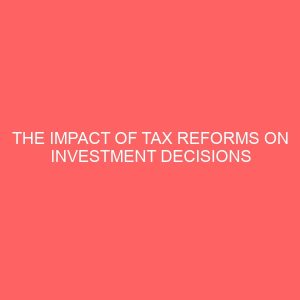Description
AN APPROVAL OF PAY-AS YOU EARN SYSTEM OF TAXATION IN NIGERIA (A CASE STUDY OF NSUKKA LOCAL GOVERNMENT AREA)
ABSTRACT
The purpose of this research work is to describe the practical approach to an appraisal of pay-as-you-earn system of taxation with referee to Nssuka local government area. To guide this study, two hypotheses were formulated. A review of literature was down to ensure solid conclusion for the study. A structural questionnaire was developed and administered by the analysis adopted in this research work was chi-square, this method by researcher to ensure that result obtained were real and not by chance.
Based on the above statement some of the major findings include presentation of data and their analysis. The chapter five is discussing a bout the findings made by the researcher and recommendation as well as conclusion.
Conclusively, the researcher will add to the existing literature on an appraisal of pay-as-you0-earn system of taxation. Scope of study and limitation talk about the areas the researcher is going to touch when discussing on the appraisal of pay-as-you-earn system of taxation system are place or area that have been unable to by researched upon to time.
TABLE OF CONTENT
Title page …………………………………………………….(i)
Approval page…………………………………………… ….(ii)
Dedication……………………………………………… .….(iii)
Acknowledgment…………………………………………….(iv)
Abstract……………………………………………………….(v)
Table of contents…………………………………………………..
CHAPTER ONE
0.1 INTRODUCTION ………………………………………………
1.1 Statement of Problem…………………………………….
1.2 Purpose of the Study …………………………………….
1.3 Significant………………………………………………..
1.4 Statement of Hypothesis…………………………………
1.5 Scope of the Study…………………………………………..
1.6 Limitation of the study……………………………………
1.7 Definition of terms……………………………………..
CHAPTER TWO
2.0 REVIEW OF RELATED LITERATURE………………
2.1 Definition of Taxation…………………………………..
2.2 Functions of Taxation ……………………………………..
2.3 Ways of Regulating Taxation …………………………….
CHAPTER THREE
3.0 RESEARCH DESIGN AND METHODOLOGY
3.1 Sources of Data ……………………………………………
Primary Data…………………………………………
Secondary Data…………………………………….
3.2 Samples used……………………………………………….
3.3 Method of Investigation …………………………………….
CHAPTER FOUR
4.0 Data Presentation and Analysis……………………………
4.1 Data Presentation and Analysis……………………………
4.2 Text of Hypothesis…………………………………………
CHAPTER FIVE
5.0 SUMMARY OF FIN DINGS CONCLUSION AND RECOMMENDATION
5.1 FINDINGS …………………………………………………
5.2 CONCLUSION ……………………………………………
5.3 RECOMMENDATION ……………………………………
BIBLIOGRAPHY……………………………………………
APPENDIX…………………………………………………
CHAPTER ONE
1.0 INTRODUCTION
The global economic recession, which started in 1980’s as a result of decline in the economic growth of industries nation, high rate of inflation, dramatics rise in price of crude oil, increase cost of important a massive building-up of liquidity in the international capital market and unusual fluctuation in commodity prices was not fully felt in Nigeria until 1982, when the developed countries applied a series of restructure monetary and fiscal policies to curtail the a fore-stated problems.
Seventeen years ago, precisely in 1983, the worldbank report that the continuing recession in the industrial world several constrained developed countries growth in 1982. Weakness in the price of oil created difficulties for oil exporting developing countries’’.
Reporting specifically on Nigeria, the bank stated that“ foreign exchange resource declined in 1982 from a level equivalent to three month worth. Investment, equal to about a third of gross domestics product (GDP) in 1980 –1981, has been radically reduced as both foreign exchange and government resource contract (85% of government revenue, both federal and states are direct generated from oil export).
An attempt to wriggle the country out of its financial predicament led to the initially of series of belt-tighten measure since 1982 to date.
These measure include:
Ban on import of a large number of goods, specially taxes on luxury goods, enforcement of trick exchanges control reputation liberalized during the earlier boom, wages and ban on employment in the public sector, increased external







